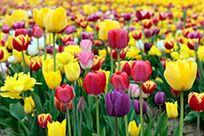Bulbs 101: How to Choose, Plant, and Care for Flower Bulbs
 |
Here are some simple things to remember when planting:
Planting bulbs in well-drained soil is vital and the most important instruction we can give you. (Bulbs can rot in soggy, overly wet ground.) Before planting your bulbs, mix a slow-release, complete fertilizer into the soil in the bottom of the hole, then add a little more soil so that the bulb itself doesn’t come in contact with the fertilizer granules. You can find appropriate bulb fertilizers at Gertens Garden Center. Don’t use any strong commercial fertilizer or fresh manure when planting bulbs.
When planting, you may wonder how deep is deep enough? As a general rule, most bulbs should be planted at a depth equal to three times their diameter. For example, plant a 2-inch bulb 6 inches deep. Remnants of roots on the bottom of the bulb should tell you which side of the bulb points down. If you see no sign of root remnants, plant the bulb so that the most pointed narrow part points up.
If you have heavy clay soil, try planting at one-half the recommended depth. The bulb won’t have to expend as much energy struggling through the dense clay. You can plant bulbs individually by using a hand trowel or bulb planter. If you are planting many bulbs, dig one big trench or hole and place the bulbs in the bottom. After planting the bulbs, be sure to water them thoroughly.
Always cut as little foliage as possible when cutting flowers from your bulbous plants. The leaves and foliage are essential for storing food for next year's blooming. Let the foliage die back on its own in the garden before trimming it back or digging up the bulbs. Do not trim back healthy green foliage or the bulb will not perform well next year.
Never dry bulbs in the sun, always in the shade in a well-ventilated area. Store bulbs in a dry, well-ventilated area to prevent mold or mildew. Don’t store them in an air-tight container.

The planting method and type of bulb you choose will depend on the design style you want to achieve: natural or formal. Naturalizing refers to the ability of some bulbs to come back year after year. Some of the tulip species are good naturalizers, as are some crocus and many daffodils (and many other bulbs). In a naturalistic design, you do your best to imitate a natural planting for a particular bulb type. Choose bulbs that go on to naturalize on their own, thereby making the planting look more natural year after year. Formal designs are commonly seen in public gardens, but are also possible in the home garden. In a formal planting a hundred or more of the same bulb may be required to fill the bed. After the flowers are done blooming you can compost the bulbs and plant summer bulbs or remove the fading bulbs to an out-of-the way spot where they can ripen. They can then be replanted in the formal bed the following autumn after the summer flowers have finished their display.
Beware of the critters! A gardener can be pretty perplexed when the 200 bulbs they planted last fall make just a meager showing in the spring. The reason could be inferior bulb quality or improper planting depth, but a likely culprit could be an animal. Chipmunks, voles, mice, deer, woodchucks, squirrels and other animals forage for and feast on newly planted bulbs.
Consider the following:
· Use animal repellents
· Most critters leave daffodils & snowdrops alone, which is why these plants naturalize so well.
· Use bulb fertilizer or super phosphate instead of bone meal, which can attract animals.
· If burrowing animals are a problem, plant your bulbs in wire mesh bulb baskets.
· Use traps or barriers as deterrents
With these tips in mind, you’re ready to plant your bulbs. It will be spring before you know it and your TLC will be well received by your beautifully blooming bulbs.
